Missisquoi Camp Meeting Sheldon Vermont
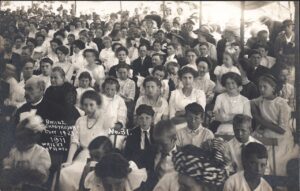
July 1911 Wisconsin
Sheldon Camp Meeting began as an outgrowth of the Chautauqua movement from the 1870s. More than 200 permeant assemblies across American engaged in presenting concerts and speakers and soon transformed into large gatherings in permeant, or seasonal, settings for evangelical preaching.
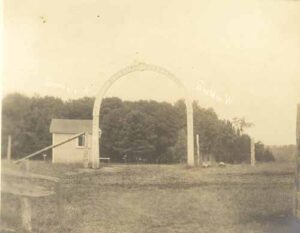
Main Entrance
On a 40 acre wooded lot along Vermont Route 105 near the present day Hartman Farm, the Camp Meeting directors established the Missisquoi Camp Meeting. According to Onida Davis Schwartz, historian of the Missisquoi Campground, the site could be reached both by car and by rail. Fairly level ground made walking easy, allowed for the pitching of tents and for the building of cabins and cottages along the river. Situated between Saint Albans and Enosburg allowed for easy access while being sufficiently out of the way to afford privacy.
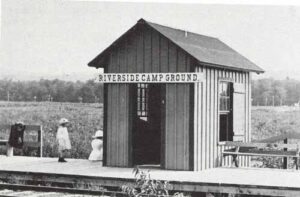
Rail Station
Although the railroad served passenger stations in Sheldon Junction and at South Franklin, a small seasonal passenger station accommodated Riverside Campground passengers attesting to the great number of people attending the camp meetings. Although located directly across a field from the entrance to the camp ground, which is not visible in this photo but is behind the station, passengers trek across the field to get to the camp.
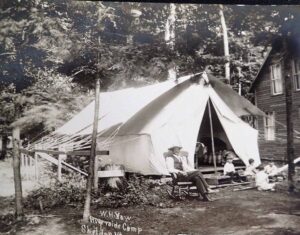 Initially week long visitors to the camp ground pitched tents to call home.
Initially week long visitors to the camp ground pitched tents to call home. 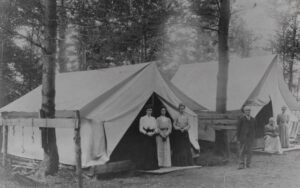
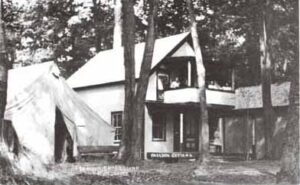
By 1882 attendance at both the Missisquoi and Morrisville, VT increased with 2500 people at some of the meetings. As summer assemblies continued to grow, cabins replaced tents. The final “cabin row section” of the last Camp Missisquoi campsite hosted not less than 6 cabins along the river.
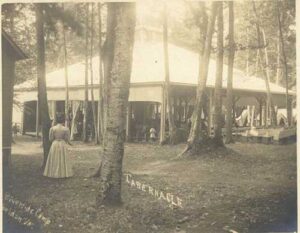
The evangelical presentations took place in the “Tabernacle” The open pole style structure hosted seating on hand hewn logs arranged in rows with a stage and altar at the front.
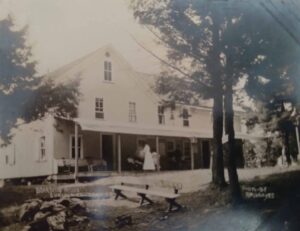
The Grove House served as both the kitchen – dining hall and a guest house. Guests paid $1.25 per day for boarding. Horses could be cared for at 25 cents per day. The U S Postal Service delivered mail daily from Enosburg Falls.
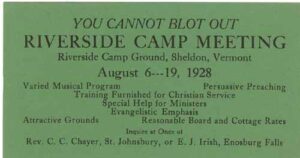
Along side evangelical work the camp activity focused on the whole soul. Sports including baseball, football, tennis, running, boating, and swimming became part of each day. Both vocal music and a 12 piece orchestra entertained for enjoyment and spiritual movement.
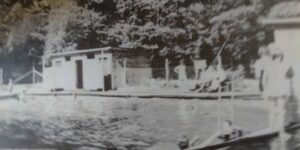 During the 1940’s the Vermont Conference merged with the Troy Conference of the United Methodist Church. The original “camp meeting’ format gave way to the development of a campsite for youth. New and additional facilities completed at the time included a pool. As weekly camps during the summer replaced revivalist meeting the board of directors secured funding to upgrade the site. Both a “Directors” cabin and a Nurse’s residence added to the comfort of those who spent time attending to the needs of youth.
During the 1940’s the Vermont Conference merged with the Troy Conference of the United Methodist Church. The original “camp meeting’ format gave way to the development of a campsite for youth. New and additional facilities completed at the time included a pool. As weekly camps during the summer replaced revivalist meeting the board of directors secured funding to upgrade the site. Both a “Directors” cabin and a Nurse’s residence added to the comfort of those who spent time attending to the needs of youth.
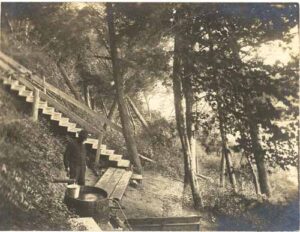 Although the main grounds lay flat upon the river bank the decent to the river took more effort. Before the construction of a “Spring House” near the pool including a pump to move the water from this spring up to the new reservoir, water for campers took a trip down these stairs to this “spring” .
Although the main grounds lay flat upon the river bank the decent to the river took more effort. Before the construction of a “Spring House” near the pool including a pump to move the water from this spring up to the new reservoir, water for campers took a trip down these stairs to this “spring” .
The Missisquoi River provided opportunities for recreation and for baptisms of those able to make the trip down the stairs.
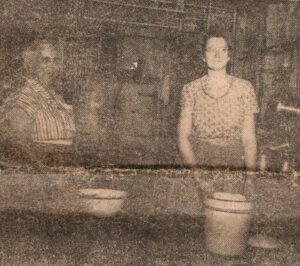 In August 1954, the Vermont Sunday News reported upon the success of the Missisquoi Camp. “It is a heart warming experience to observe children being taught by teachers wo dedicate themselves to the service of mankind.” They reported that over the five week program almost 200 youth attended camp. In this photo Mrs. Helen Maynard and Mrs. Gynette Hugaboom serve food to the campers that they have attended to for nearly 10 years.
In August 1954, the Vermont Sunday News reported upon the success of the Missisquoi Camp. “It is a heart warming experience to observe children being taught by teachers wo dedicate themselves to the service of mankind.” They reported that over the five week program almost 200 youth attended camp. In this photo Mrs. Helen Maynard and Mrs. Gynette Hugaboom serve food to the campers that they have attended to for nearly 10 years.
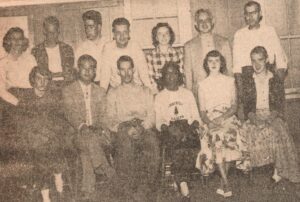 The 1984 Camp Missisquoi Staff – James Shepard of the Vermont Sunday News
The 1984 Camp Missisquoi Staff – James Shepard of the Vermont Sunday News
Back Row: Mrs. Calvin Seiforth, Rev. Frank Blanchard, Paulo Wright, Rev. Charles Latimer, Erlene Bishop, Rev. Johnson Cambridge, Stanley, Chyet.
Front Row: Leona Hopkins, James Kim, Rev. Calvin Seiforth, Eleanor Evans, Alta Sandoz, Ruth Glazier.
A long standing Sheldon family purchased the camp ground in 1989. The wife served previously at the camp and each of the children attended camp during their youth. Although now a private site it continues to hold memories for many former staff and campers. The camp ground buildings fell victim to years of Vermont winters and neglect for a lack of sufficient funding to keep the grounds and buildings viable. Although a private residence now stands on the former soccer field, the remainder of the unused buildings continue to stand.
